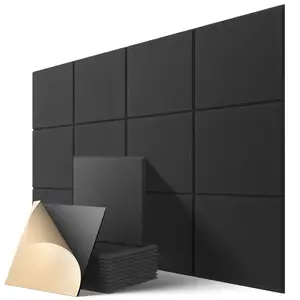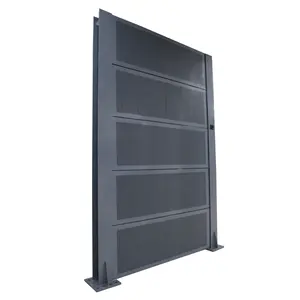(1422 products available)




















































































































































































































A highway noise barrier is a material constructed along roads or highways. Its primary purpose is to reduce noise pollution from vehicles, especially in residential or sensitive areas nearby. These barriers, often called sound walls or noise walls, work by reflecting, absorbing, or blocking sound waves, creating a quieter environment for those living or working near the road. They are crucial for urban planning and traffic management, promoting a balance between infrastructure and community well-being.
Highway noise barriers come in different types, which are listed below:
Reflective highway noise barriers:
Reflective sound barriers are also known reflective walls. They are designed to reduce noise pollution from vehicles by reflecting sound waves back towards the source. They achieve this through their high-density structure and smooth surface, which facilitates the efficient reflection of sound. The design and placement of these barriers aim to minimize the amount of noise that reaches residential or sensitive areas nearby.
Absorptive highway noise barriers:
Absorptive sound barriers, or noise walls, are specifically designed to reduce traffic noise pollution in surrounding areas. They do this utilizing a porous and soft material that scatters and absorbs sound waves, thus minimizing the reflection of sound into adjacent residential or sensitive areas. The primary goal of these barriers is to create a quieter environment for those living or working near busy roads or highways.
Transparent highway noise barriers:
Transparent noise barriers are a type of highway noise barrier that effectively reduces traffic noise while maintaining visual openness. Typically made from materials like acrylic or polycarbonate, they allow light to pass through, minimizing the obstruction of views. These barriers strike a balance between noise reduction, safety, and aesthetic considerations.
Composite highway noise barriers:
Composite noise barriers are a popular choice for highway construction. They combine various materials, often including wood or recycled plastic, bonded to a concrete mixture. This combination results in a product that is both effective at reducing noise pollution and durable, capable of withstanding harsh weather conditions without deteriorating.
Perforated highway noise barriers:
Perforated noise barriers are designed with an array of small holes or patterns on their surface. These barriers help reduce traffic noise levels in surrounding areas. The design allows for sound wave diffusion and absorption through the perforations, thereby minimizing the reflection of noise into adjacent residential or sensitive areas.
Highway noise barriers are essential for reducing noise pollution in residential areas. Their features and functions include:
Materials
A highway noise barrier is made of different materials. Materials used to construct noise walls include concrete, metal, wood, and plastic. Materials are durable and sturdy. They don't get damaged easily, and their lifespan is long. Some materials are good at absorbing sound, while others reflect noise. For example, concrete walls absorb sound, while metal and wood reflect noise. The material's choice affects the noise barrier's effectiveness.
Height
The height of a highway noise barrier affects its ability to block noise. Barriers need to be tall enough to reduce noise pollution in residential areas. The height is determined by the amount of noise that needs to be reduced and the area it protects. Noise barriers have signs indicating the maximum height limits during construction.
Design
Highway noise barriers come in different designs. Some designs are better at reducing noise than others. For instance, solid walls are more effective than see-through barriers. The design makes them effective at blocking noise from the highway to nearby areas. Noise barriers also have patterns that blend well with the environment.
Durability
Highway noise barriers are constructed with materials that can withstand different weather conditions. They are exposed to harsh weather, such as heavy rainfall and strong winds. The weather may cause damage to the barriers, but they remain intact. The barriers' durability ensures they remain effective for many years. The barriers are also easy to maintain since they don't require frequent repairs.
Installation
Noise barriers are easy to install. They come with installation guidelines that need to be followed to ensure they are correctly fixed. Some barriers are modular, allowing for easy assembly and disassembly. Once the barriers are assembled, they remain sturdy and durable.
Noise barriers are installed along major roads and highways, especially in urban areas, to shield nearby residents from excessive noise. They are also set up in construction sites, industrial plants, and factories to minimize noise pollution emanating from such places and keep it within a certain limit.
Sound barriers for highways are also installed in airports near residential areas to minimize and control noise from taking off and landing planes. The barriers absorb, diffract, or reflect sound waves, thus reducing the amount of noise that reaches nearby homes and businesses.
Another application of road noise barriers is in farms located near busy highways. They help minimize noise from the highway, which could otherwise interfere with the farming activities, such as animal husbandry. For instance, loud noises could stress animals, affecting their health and productivity.
Highway noise barriers are also used in public parks and recreational facilities to reduce noise pollution from nearby roads. They create a more peaceful and enjoyable environment for visitors and residents.
Highway noise barriers are an effective way to manage noise pollution in urban and suburban areas. They provide a practical solution for maintaining peace and quiet in residential and commercial areas near busy roads, construction sites, and airports.
Reflective acoustic panels are used in hospitals and healthcare centers to minimize noise from busy streets and promote a quieter and more healing environment for patients. They are also used in schools and educational institutions to create a quieter environment more conducive to learning.
Noise-reducing barriers are an effective way of managing noise pollution, but they are not a complete solution. Urban and suburban planners must consider other solutions, such as traffic management, urban design, and land use planning to minimize the impact of noise on communities.
When purchasing a noise barrier wall, it is essential to consider different factors to ensure that the needs are met. Here are some tips on choosing the right sound barrier for highways.
Determining the purpose
It is essential to determine the reason for purchasing a noise barrier wall. Knowing the purpose will help decide the right material and design that will suit the need. A sound barrier for a highway will require different specifications from a noise barrier for residential areas.
Researching on available options
There are different types of noise barriers for highways, and it is essential to do proper research to find the one that suits specific needs and requirements. Some of the options include concrete sound barrier walls, metal sound barrier walls, and acoustic panels.
Considering the location
The location where the noise barrier will be fixed plays a significant role in choosing the right one. It is important to consider factors like weather conditions, terrain, and specific needs. For example, if the terrain is windy, then a solid barrier like a concrete noise barrier would work best. In residential areas, panels would be more appropriate.
Consulting with experts
Noise barrier for highways comes in different specifications and designs, and it is important to consult an expert to help determine the right one. Experts know the right barriers to suit different situations and will help eliminate the stress of choosing the right one.
Reading reviews
Noise barriers for highways are available from different manufacturers, and it is important to choose the right one. Reading reviews will help understand the quality of the product and how other customers rate it. It is also important to check the customer service of the manufacturer and how they handle issues.
Calculating the budget
Noise barriers come at different prices, and it is important to have a budget to avoid overspending. A budget will help narrow down options and make it easier to choose the right one. It is also important to note that consulting with an expert will require an extra cost, but it is worth it because the right noise barrier will be chosen.
Q1: What are some challenges of using noise barriers?
A1: One challenge is that sound waves can bend around obstacles, reducing the effectiveness of barriers. Barriers also need to be placed at optimal angles and distances from the source and receiver. Another challenge is that barriers can reflect noise to nearby areas rather than absorb it. For example, reflective surfaces like concrete can redirect sound. Lastly, barriers may only partially block high-frequency sounds that tend to travel straight ahead.
Q2: How does the highway noise barrier work?
A2: Noise barriers work by preventing, absorbing, or deflecting noise waves from the source to the receiver. They are constructed to be tall enough and placed at ideal distances from the source and receiver. The materials used absorb or block the noise waves.
Q3: What is the highway noise like?
A3: The noise from highways varies. It may be as low as 70 decibels (dB) in some areas and as high as 90 dB in others. 70 dB is the same as the sound level of a train passing through a location once every 15 minutes during the day. 90 dB is like the sound level of a motorcycle.
Q4: What is a good material for a highway noise barrier?
A4: Good materials for a highway noise barrier include wood, metal, and concrete. Wood and metal are easily installed, while concrete requires skilled personnel. Other materials include vinyl and polyester.
Q5: How effective are noise barriers?
A5: Noise barriers can effectively reduce noise levels by up to 10 decibels. However, for barriers to be effective, they need to be at least 5 decibels taller than the source of the noise. The height difference should be 1 meter for every 1.5 meters of distance.